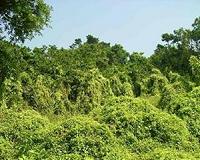 |
Fayetteville, AR (SPX) Apr 5, 2011 Containers made from plastics are used in most traditional greenhouse operations. While plastic containers are practical, strong, and can be formed to any size, shape, or color, the extensive use of these petroleum-based containers creates significant waste disposal problems for the greenhouse industry and consumers. One example: a 2008 report found that a typical greenhouse operation in California discards over 3560 pounds of plastic trays, flats, and containers annually. The amount of waste plastic generated by greenhouses has become an important issue as the industry focuses more on creating sustainable practices. Increasing the use of "biocontainers"-containers that are not produced from petroleum and that degrade rapidly when planted in the field or in a composting operation-is one way to reduce the amount of waste plastic generated by greenhouse operations. In a new study that may provide greenhouse professionals with effective "green" alternatives, researchers report on a series of experiments in which they evaluated the physical properties of a range of commercially available biocontainers and compared them with traditional petroleum-based plastic containers. Scientists Michael R. Evans, Matt Taylor, and Jeff Kuehny compared seven commercially available biocontainers with plastic containers for physical attributes such as strength, water usage, and algal/fungal growth. The results of the study were published in HortTechnology. According to Evans, corresponding author of the report, the results indicated that rice hull containers had the highest "vertical dry strength" of all containers tested. "Containers composed of 80% cedar fiber and 20% peat, composted dairy manure, and peat had lower vertical dry strengths than the aforementioned containers, but had higher vertical dry strengths than those composed of bioplastic, coconut fiber, and rice straw", Evans said. "Plastic, OP47 (bioplastic), and rice hull containers had the lowest rates of water loss per unit of container surface area, while peat, Fertil, and rice straw containers had the highest rates of water loss per unit of container surface area", the researchers noted. They recommended that in locations where water use or availability is a major consideration, biocontainers such as OP47 or rice hulls may be preferred to other biocontainers that have a higher water usage requirement. The researchers also tested "plantable" biocontainer decomposition under field conditions in greenhouses in Louisiana and Pennsylvania. Plants were grown for 5 weeks in Louisiana and 7 weeks in Pennsylvania; results showed that coconut fiber containers had the lowest level of decomposition at 4% and 1.5% in Pennsylvania and Louisiana, respectively. The authors remarked that results related to container wet strength and water requirements were the most significant findings in their research. "Because the differences in physical properties of biocontainers compared with plastic containers were specific for each type of biocontainer, greenhouse managers will need to decide which of the physical properties are most important and select biocontainers with physical properties that best match their needs." The complete study and abstract are available on the ASHS HortTechnology electronic journal web site here.
Share This Article With Planet Earth
Related Links American Society for Horticultural Science Farming Today - Suppliers and Technology
 Manage Biological Invasions Like Natural Disasters
Manage Biological Invasions Like Natural DisastersWashington DC (SPX) Apr 5, 2011 Biological invasions get less prime-time coverage than natural disasters, but may be more economically damaging and warrant corresponding investments in preparedness and response planning, according to three biologists writing in the April issue of BioScience. Anthony Ricciardi of McGill University and his coauthors point out that species invasions are becoming more frequent worldwide, lar ... read more |
|
| The content herein, unless otherwise known to be public domain, are Copyright 1995-2010 - SpaceDaily. AFP and UPI Wire Stories are copyright Agence France-Presse and United Press International. ESA Portal Reports are copyright European Space Agency. All NASA sourced material is public domain. Additional copyrights may apply in whole or part to other bona fide parties. Advertising does not imply endorsement,agreement or approval of any opinions, statements or information provided by SpaceDaily on any Web page published or hosted by SpaceDaily. Privacy Statement |